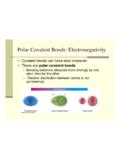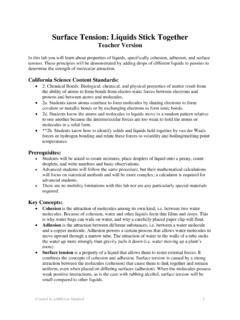Transcription of Materials Science and Engineering Problems
1 Materials Science and Engineering ProblemsMSE FacultyJanuary 31, 2022 This document includes the assigned Problems that have been included so far in the digitized portion of our 301 Organization .. Structure and Bonding .. Structure .. Properties .. Diagrams .. Transformations .. Properties .. Fracture Mechanics .. Corrosion .. Ceramics .. Polymers ..252 314 and Components .. and Extensive Properties .. Quantities and State Functions .. Data .. Equilibration .. Thermodynamics .. Component Thermodynamics .. Thermodynamics .. Computational Exercises.
2 323 315 Problems344 316-1 Problems435 316-2 .. Pressure Derivation .. Nucleation .. and Interface Effects .. Nucleation .. in a Binary System .. Decomposition .. Undercooling .. Eutectic Solidification .. Eutectoid Transormations .. Transitional Phases .. TTT diagrams .. Mineralization .. Review Questions ..726 332 Organization .. Stress Tensor .. Moduli .. Representation of Stress and Strains .. Linear Properties .. Mechanics .. Mechanics .. Weibull Statistics .. Yield Criteria .. Strengthening Mechanisms .. Viscoelasticity.
3 Nonlinear Viscoelasticity and Creep ..877 331 Problems898 351-1 Problems1039 351-2 Problems10810 361 Problems11011 390 Materials Selection in Mechanical Design .. Thermo-Calc .. DICTRA .. TC-PRISMA .. 1192 Contents1 301 Course @ with the following information:1. Any background about yourself that you want to What you have enjoyed most and have found the most frustrating about your One particular aspect of Materials Science that you would like to learn more about this Atomic Structure and Bonding2)Classify each of the following Materials as to whether it is a metal, ceramic, or polymer.
4 Justify each choice. (a.)brass; (b.) magnesium oxide (MgO); (c.) Plexiglass ; (d.) polychloroprene; (e.) boron carbide (B4C); and (f.) )Site the difference betweenatomic massandatomic )Silicon has three naturally occurring isotopes: of28Si, with an atomic weight of amu, of29Si,with an atomic wight of amu, and of30Si, with an atomic weight of amu. On the basis of these data,confirm that theaverageatomic weight of Si is )Indium has two naturally occurring isotopes:113In, with an atomic weight of amu, and115In, with anatomic weight of amu. If the average atomic weight for In is amu, calculate the fraction-of-occurrencesof these two )Address the following concepts concerning atomic How many grams are there in oneamuof material ?
5 2. Mole, in the context of this book, is taken in units of gram-mole. On this basis, how many atoms are there in apound-mole of a substance?7)Relative to electrons and electronic states, what does each of the four quantum numbers specify?8)Give the electron configurations for the following ions: P5+, P3 , Sn4+, Se2 , I and Ni2+.9)Potassium iodide (KI) exhibits predominately ionic bonding. The K+and I ion have electron structures that areidentical to which two inert gases?10)Without consulting Callister Figure or Table , determine whether each of the following atomic electronconfigurations is an inert gas, a halogen, an alkali metal, an alkaline earth metal, or a transition metal.
6 List the numberof valence electrons for each atom (except for the transition metals). Justify your 1s22s22p63s23p52. 1s22s22p63s23p63d74s23. 1s22s22p63s23p63d104s24p64. 1s22s22p63s23p64s15. 1s22s22p63s23p63d104s24p64d55s26. 1s22s22p63s2311)The atomic radii of Mg2+and F-ions are and nm Calculate the force of attraction between the two ions at their equilibrium interionic separation ( , when the ionsjust touch one another).2. What is the force of repulsion at this same separation distance?12)The force of attraction between a divalent cation and a divalent anion is 10 8N. If the ionic radius of thecation is nm, what is the anion radius?
7 Here we re provided with the two pieces of information: the force of attraction between a cation/anion pair and thecation s atomic radius. With this information and an understanding of the Coulomb interaction we can calculate theanion force of attraction between two isolated ions is defined by Callister Eq. :13)The net potential energy between two adjacent ions,EN, may be represented by the sum of Callister and That is:EN= Ar+Brn( )Determine the equilibrium ionic bond energy,E0, in terms of the parametersA,B, andn. Note that equilibrium occurswhen the net force on the ions is zero. Use the following procedure:1.
8 DifferentiateENwith respect torto acquire the expression for the Assume two adjacent ions aENversusris minimum Solve forrin terms ofA,B, andn, which yieldsr0, the equilibrium interionic Determine the expression forE0by substitutingr0into the )For an Na+-Cl-ion pair, attractive and repulsive energies (EAandER, respectively), depends on the distancebetween ions:EA= eV nmr( )ER= 10 6eV nm8r8( )1. Superimpose on a single plot (by hand or using plotting software)EA,ER, and the net energyENup tor= :You may have to truncate the plot on they-axis for good From this plot, derive the equilibrium spacing,r0and the magnitude of the bonding energy,E0at the Now consider instead a K+-Cl-bonding pair.
9 The K+ion is larger, which changes the repulsive termERto be:ER= 10 6eV nm9r9( )Without plotting the newEN, how do you expectE0andr0to change for the K+-Cl-ion pair?15)Briefly discuss the main differences between 1.) ionic , 2.) covalent, and 3.) metallic )Plot the bonding energy vs melting temperature for the following Energy (kJ/mol)Melting Temperature ( C)Hg62-39Al330660Ag282962W8503414 Using this plot, approximate the bonding energy for molybdenum, which has a melting temperature ofTM=2617 )Compute the percent ionicity (&IC) of the interatomic bonds for each of the following compounds: MgO, GaP,CsF, CdS, and FeO.
10 Which would we consider primarily ionic , and which would we consider primary covalent?Semiconductors typically possess covalent bonds - which of the compounds above do you expect is (are) used as insemiconductor applications?18)What are the predominant type(s) of bonding would be expected for each of the following Materials : solid xenon,calcium fluoride (CaF2), bronze (a copper alloy), cadmium telluride (CdTe), rubber, and tungsten? Crystal Structure19)The body-centered cubic (BCC) crystal structure is shown below in Fig. Demonstrate the following:1. The unit cell length (also referred to as a lattice parameter) isa=4r/ 3, whereris the atomic The atomic packing factor (APF) is :The BCC is the first problem you have in navigating and performing calculations on basic unit cells.







